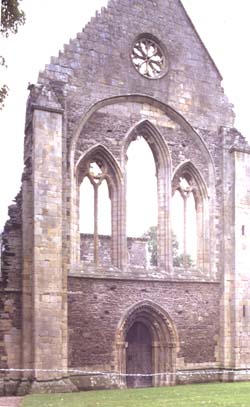 |
 |
 |
 |
 |
 |
 |
|
|
Cistercian Abbeys: VALLE CRUCIS Name: VALLE CRUCIS Location: nr
Llangollen County: Denbeighshire Valle Crucis was founded in 1201 by Madoc ap Gruffydd (d. 1236), ruler of the Welsh principality of Powys. The abbey was named after the ‘Valley of the Cross’, the lush green landscape in which it was situated. The valley itself took its name from the ninth-century Pillar of Eilseg, a memorial cross which stands near to the site of the abbey. This was built as a monument to the glories of the former kings of Powys, whose armed intervention contributed to the maintenance of Welsh independence after the Norman Conquest of 1066. During the Middle Ages, Valle Crucis Abbey was also known as the abbey of ‘Llanegwestl’, from the original Welsh name for its site. Thirteen monks and an abbot arrived from Strata Marcella, near Welshpool, and building work began almost immediately. The monks were granted access to extensive grazing lands for their flocks and herds on the granges at Mwstwr and Buddugre and also held arable fields, water meadows and woodland areas. The abbey had a comfortable income, although it is doubtful if the number of monks increased from the original thirteen. A few years after the foundation, the General Chapter of the Cistercian Order reprimanded the abbot of Valle Crucis, along with those of Aberconwy and Caerleon, because it was reported that they rarely celebrated Mass or even received the Holy Eucharist. It seems that the community lived a lifestyle bordering on luxury. In the fifteenth century Guttyn Owain praised the hospitality of the abbots, remarking that the table was usually spread with four meat courses served in silver dishes and accompanied by ‘sparkling claret’. During the late fifteenth century the monks' dormitory was completely taken over to be used as a grand set of apartments, in which the abbots must have lived in semi-secular comfort. The abbey suffered some misfortunes throughout
the centuries. Some time during the first fifty years of its existence,
and before the abbey could be completed, a disastrous fire swept
through the monastery, necessitating considerable reconstruction.
Evidence of the damage can still be seen on the lower stonework,
which was stained deep red by the fire. During the Welsh wars
of
King Edward I, in 1276-77 and 1282-83, the abbey suffered at the
hands of the English and the buildings were significantly damaged.
In 1284, Valle Crucis was granted £160 by way of compensation
for the losses incurred. Some scandal surrounded the last years
of the monastery. In 1534 the penultimate abbot, Robert Salusbury,
was accused of many crimes and excesses and the following year
was
arrested for his part in a highway robbery. At the time of the
Dissolution the abbey had a net annual income valued at £188
and the monastery was finally surrendered in January 1537. Following
the Dissolution,
the site passed to William Pickering and later to the Wootton family.
The church soon fell to ruin, but the east range was converted
into
a dwelling house. The house was later used as a farmhouse and continued
to serve as such into the nineteenth century. In 1950 the property
passed into the care of the government and today is managed by
Welsh Historic Monuments. Extensive remains include
the church,
the east range of the claustral buildings and the foundations of
the south and west ranges. The site, noted for its great natural
beauty, is accessible to the public and can be visited at all reasonable
hours.
|
